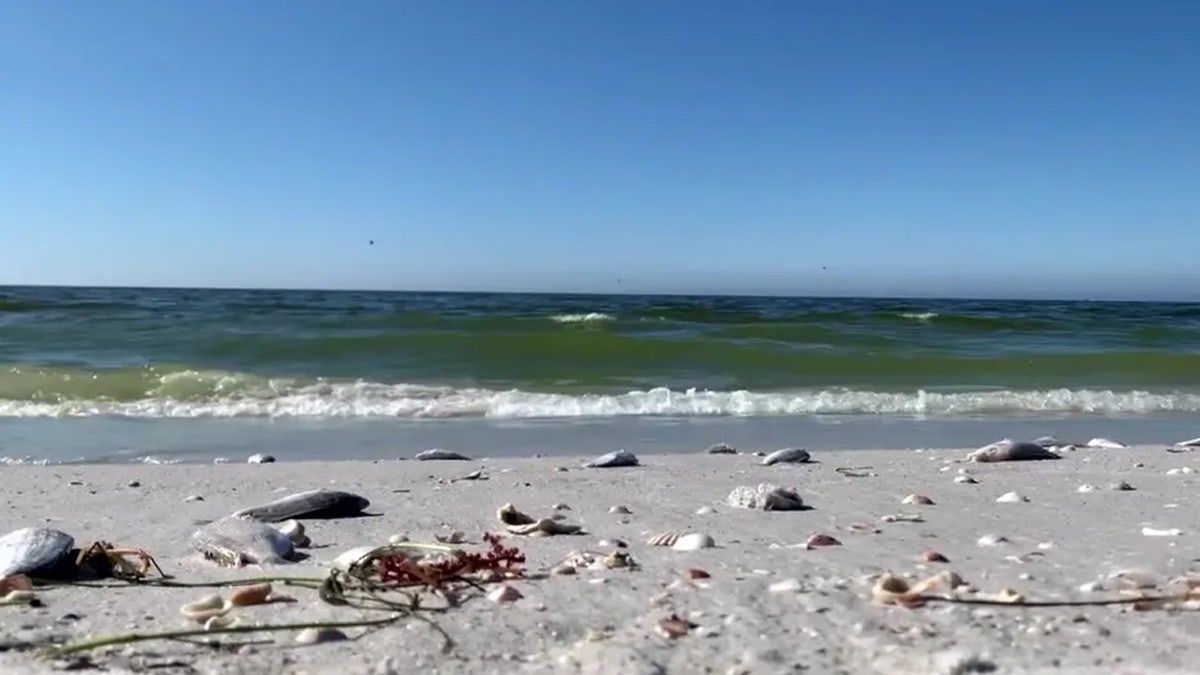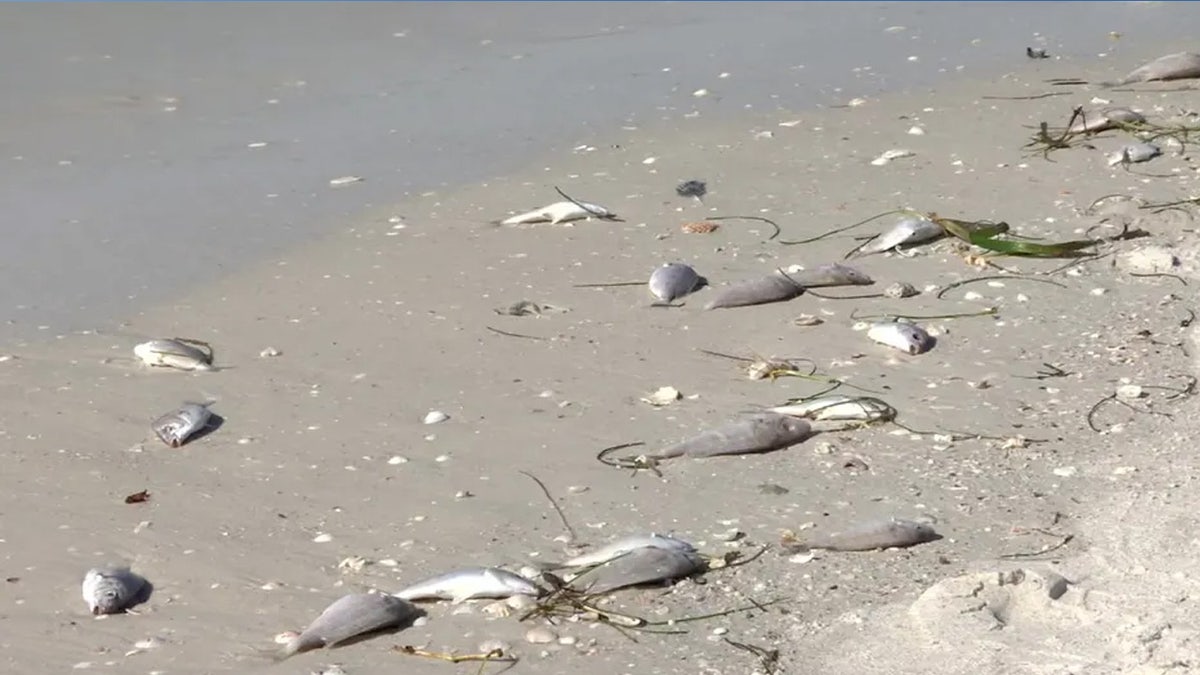Fox News Flash top headlines for December 13
Fox News Flash top headlines are here. Check out what's clicking on Foxnews.com.
Red tide, a harmful algal bloom that grows in salt water, is making its way to Florida shores from the Gulf of Mexico and it has killed large schools of fish in recent weeks.
The National Oceanic and Atmospheric Administration (NOAA) reports that "Florida ‘red tide’ occurs almost annually along portions of the state's Gulf Coast" and can result in beach and shellfish closures. Red tide, also known as Karenia brevis algae, produces toxins that can cause death or respiratory irritation in fish, dolphins, turtles, manatees and birds.
In St. Pete Beach, a resort city set on a barrier island in Pinellas County, approximately 1,500 pounds of dead bait fish were removed from the shoreline over the weekend.
FLORIDA SCIENTISTS DISCOVER TOXIC ALGAE LEVELS ALONG THE COAST
The cleanup was conducted by the City of St. Pete Beach and researchers have detected red tide in surrounding waters, a spokesperson for Pinellas County told Fox News Digital.

Mass groups of dead bait fish washed up on St. Pete Beach and other beaches in Pinellas County, Florida, in early December. Red tide, a harmful algal bloom that produces toxins that are deadly to marine life, was found to be the cause. (FOX 13 Tampa)
"Red Tide (K. Brevis) concentrations vary from day to day based on the winds and currents," County Spokesperson Tony Fabrizio said in an emailed statement.
"We are currently most affected on the south side of the County – specifically, Pass-a-Grille and Treasure Island over the last few days," Fabrizio continued. "We’re hopeful that the cold fronts and stronger winds that we’re going to start seeing as soon as this weekend will eventually disperse the bloom, but of course there are no guarantees."
Red tide detection and fish kills have been occurring in Florida’s southwestern region since October, including Sarasota County, Fort De Soto Park in Pinellas County, according to reporting from FOX 13 Tampa Bay.
Carly Jones, a public information specialist for Florida Fish and Wildlife Conservation Commission’s (FWC) Fish and Wildlife Research Institute, confirmed to Fox News Digital that the agency has seen elevated counts of red tide organisms in Southwest Florida.
THOUSANDS OF NEEDLE-NOSED FISH WASH UP ON CAPE COD SHORES: REPORT
"We have received reports of fish kills suspected to be related to red tide from Pinellas, Manatee, Sarasota, Lee, and Collier counties," Jones wrote in an email.
Health experts have found that red tide toxins can have an adverse impact on humans as well.

Red tide is a harmful algal bloom that grows in salt water that can cause skin irritation because the organism produces toxins. (iStock)
Some people experience respiratory irritation, such as coughing, sneezing, tearing and itchy throat, when red tide is present and winds blow the organisms onshore, Jones explained.
"Offshore winds usually keep respiratory effects experienced by those on the shore to a minimum," Jones wrote to Fox News Digital. "The Florida Department of Health (FL DOH) advises people with severe or chronic respiratory conditions, such as emphysema or asthma, to avoid red tide areas."
MASS FISH DEATHS FOUND IN GEORGIA CREEK FOLLOWING SOYBEAN SPILL
The NOAA notes that red tide toxins can also contaminate shellfish, can attack the central nervous systems of marine life and can sicken pets if they cross paths with or eat dead fish on shorelines.
The FL DOH is advising Florida residents and visitors to refrain from swimming in or near waters where red tide has been detected because the produced toxins can cause skin irritation, rashes, burning and sore eyes.
Beach- and health-related red tide information can be found at VisitBeaches.org – an online beach conditions reporting system – and FloridaHealth.gov – the state’s public health and safety website.
Jones told Fox News Digital that the FWC will continue to monitor the current red tide bloom.
CLICK HERE TO GET THE FOX NEWS APP
People can keep track of red tide conditions on the FWC’s daily sample map and current status report, both of which are on MyFWC.com.
As the name suggests, the presence of red tide often turns water red, according to the NOAA.

Approximately 1,500 pounds of dead fish were removed from St. Pete Beach as authorities responded to a recent red tide fish kill. (FOX 13 Tampa)
A single harmful algal bloom event can reportedly impose millions of dollars in losses in coastal communities.
Red tide events have been seen to "last as little as a few weeks or longer than a year" in Florida and can "even subside and then reoccur," the NOAA reports.
FOLLOW US ON FACEBOOK FOR MORE FOX LIFESTYLE NEWS
The state of Florida has a Red Tide Task Force under the Florida Department of Environmental Protection.
Task force information on harmful algal blooms can be found on ProtectingFloridaTogether.gov, a water quality and environmental transparency website.
Suspected harmful algal blooms can be reported online at any time of day at ReportAlgalBloom.com or by phone toll-free at 855-305-3903 from Monday to Friday (8 a.m. to 5 p.m. EST).
CLICK HERE TO SIGN UP FOR OUR LIFESTYLE NEWSLETTER
Protecting Florida Together says red tide fish kills can be reported to 800-636-0511, and wildlife strandings can be reported to 888-404-3922.





















